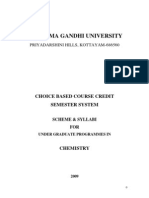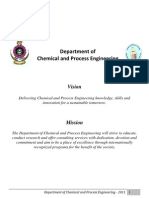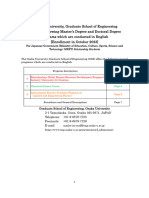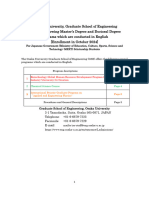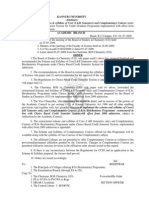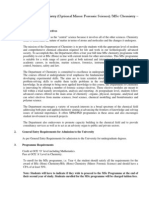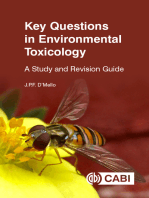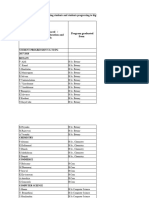الخطة الدراسية قسم الكيمياء كلية العلوم تبوك
الخطة الدراسية قسم الكيمياء كلية العلوم تبوك
Uploaded by
Murad AlDamenCopyright:
Available Formats
الخطة الدراسية قسم الكيمياء كلية العلوم تبوك
الخطة الدراسية قسم الكيمياء كلية العلوم تبوك
Uploaded by
Murad AlDamenOriginal Description:
Copyright
Available Formats
Share this document
Did you find this document useful?
Is this content inappropriate?
Copyright:
Available Formats
الخطة الدراسية قسم الكيمياء كلية العلوم تبوك
الخطة الدراسية قسم الكيمياء كلية العلوم تبوك
Uploaded by
Murad AlDamenCopyright:
Available Formats
Cover Page
Bachelor Degree Study Plan
University
Tabuk
College:
Science
Department:
Chemistry
Date:
10/3/2012
Part I
Conceptual Formwork
1- College/Faculty of Science
A) Background
History:
Faculty of Science, has been established by the Council of Higher Education No.
15/37/1426 H., and the approval of the Custodian of the Two Holy Mosques Prime Minister - and Chairman of the Board of Higher Education under God's
protection guidance wire Decree No. 9683 / m. Dated 5/8/1426 H, was a branch
of the King Abdul Aziz University in Tabuk.
B) Vision, Mission, and Objectives
Vision:
Faculty of Science is looking to be in the ranks of the internationally recognized
colleges, and a bridge of excellence in the education of students, and innovative
research, and community participation that contribute to economic growth,
sustainable development, and improve the quality of life locally, regionally, and
internationally.
Mission:
Preparation and the creation of distinct graduates in basic science and technology
and a high level of scientific competence and ethics of the profession committed
to the process and able to compete and perform the duties assigned to them with
high quality locally, regionally and internationally and contribute to solving
society's problems.
Objectives:
1. Developing and raising the efficiency of students.
2. Developing of the skills and abilities of the staff members .
3. Developing of curricula for college scholarships and updated.
4. Cooperation and coordination with the local and regional relevant authorities.
5 - Developing scientific research.
C) Academic Departments
Department of Mathematics.
Department of Physics.
Department of Chemistry.
Department of Biology.
Department of Statistics.
Department of Biochemistry.
D) Degrees Offered
2
2- Department of Chemistry
A) Background
History:
The department of Chemistry, Faculty of Science at the University of Tabuk, has
established on the academic year 2008 2009; three years later after the
establishment of the faculty.
B) Department Vision, Mission, and Objectives
Vision:
The Chemistry Department is dedicated to producing knowledgeable graduates for
careers in academia, industry and government, conducting significant research in
chemistry, promoting a diverse population of faculty, staff and students, and promoting
the collegial exchange of ideas, independent thought, and the highest ethical standards.
Mission:
The mission of the Chemistry Department is to provide a curriculum and
environment that enables students to achieve a level of knowledge of chemistry
with local and regional standards. We provide students with the scientific
knowledge and experimental skills necessary for a career in chemistry or related
fields.
Objectives:
The Department aims to provide excellent teaching and dynamically updated
programs in Chemistry, promote vigorous research, support the professional and
psychosocial, development of the faculty and co-academic personnel, adhere to
ethical standards of scholarship and professionalism.
C) Department Study Plan Objectives
Brief note on the study plan:
The courses are divided through eight semesters (including two for the
preparatory year). The courses are classified into two categories - compulsory,
and restricted-elective (from the department courses).
D) Requirements of Degree
The department of Chemistry at the University of Tabuk awards the Bachelor of
Science (B.Sc.) degree according to the credit hours system (total 132 Credit
Hours). In order to award the B.Sc., the GPA of the student should not be less
than 2 (fair).
Part II
Study Plan Templates
Table 2
Study Plan General Components
Prerequisites
University Courses
College Courses
Department Courses
Credits
Courses
Compulsory
Compulsory
Compulsory
Electives
20
25
72
8
9
7
26
4
Compulsory
133
49
Courses from Mathematics
Department
Total
Note:
University Courses (10-20%)
Faculty Courses (10-20%)
Department Courses (60-80%)
o
Compulsory (50%)
Electives (6-8%)
Free Courses -if any- (2-4%)
Weights %
Table 3
University Prerequisites
Courses Title
1
2
3
4
5
6
7
8
9
Communication Skills
Computer Skills
Learning, Thinking,
&Research Skills
Language Skills
Islamic Culture 1
Islamic Culture 2
Islamic Culture 3
Islamic Culture 4
Writing Skills
Total
Course Code
Credits
Weight
COMM 001
CSC 001
Credit
2
3
Contact
2
4
LTS 001
ARAB 101
ISLS 101
ISLS 201
ISLS 301
ISLS 401
ARAB 201
2
2
2
2
2
2
20
2
2
2
2
2
2
22
Prerequisit
es
ISLS 101
ISLS 201
ISLS 301
ARAB 101
Table 4
College Compulsory Prerequisites
Courses Title
Course
Code
Contact Hours
Theoretical
1
2
3
4
5
6
7
Mathematics 1
English 1
General Physics
English 2
General Biology
General Chemistry
Mathematics 2
Total
MATH 100
ELS 001
PHYS 101
ELS 002
BIO 101
CHEM 101
MATH 101
3
3
3
15
3
3
3
45
practical
Credit %
Prerequisites
Training
3
3
3
5
3
3
3
25
ELS001
MATH 100
Table 5
Department Elective Prerequisites
Courses Title
Course
Code
Contact Hours
Theoretical
1
2
3
4
5
6
7
8
9
10
11
12
Chemistry of Cement
Environmental Chemistry
Chemotherapy
Chemistry of Synthetic
Detergents
Chemistry of Nucleic
Acids
Chemistry of Dyes
Analysis of Industrial
Products
Biochemistry
Technology of Anticorrosion Coatings
Chemistry of Natural
Products
Chemistry of Polymers
Chemistry of Petroleum
and Petrochemicals
CHEM 324
CHEM 325
CHEM 326
CHEM 333
2
2
2
1
CHEM 434
CHEM 432
CHEM 415
2
1
CHEM 438
CHEM 445
1
2
CHEM 337
CHEM 436
CHEM 437
practical
Credit %
Prerequisites
Training
2
2
2
2
CHEM 322
CHEM 311
CHEM 232
CHEM 232
CHEM 232
2
2
CHEM 331
CHEM 311
2
2
CHEM 232
CHEM 441
CHEM 232
1
2
2
2
CHEM 431
CHEM 232
Table 6
Department Core Prerequisites
Courses Title
1
2
3
4
5
6
7
8
9
10
11
12
13
14
15
16
17
18
19
20
21
22
23
24
25
26
General Chemistry (1)
Fundamentals of Organic
Chemistry (1)
General Chemistry (2)
Volumetric and
Gravimetric Chemical
Analysis
Fundamentals of Organic
Chemistry (2)
Chemical
Thermodynamics
Electrochemistry (1)
Inorganic Chemistry (1)
Chemical Kinetics
Heterocyclic Compounds
Methods of Instrumental
Analysis
Quantum Chemistry
Electrochemistry (2)
Inorganic Chemistry (2)
Methods of
Chromatographic
Separation
Practical Physical
Chemistry
Site Training
Organic Reaction
Mechanisms
Inorganic Reaction
Mechanisms
Nuclear Chemistry and
Radiochemistry
Corrosion of Metals and
Controlling the Corrosion
Phenomenon
Surface Chemistry,
Catalysis and Colloids
Spectroscopy of Organic
Compounds
Spectroscopy of Inorganic
Compounds
Practical Inorganic
Chemistry
Research Project
Total
11
Course
Code
Contact Hours
Credit %
Prerequisites
Theoretical
practical
CHEM 201
CHEM 231
3
3
3
3
4
4
CHEM 202
CHEM 211
3
3
3
3
4
4
CHEM 201
CHEM 201
CHEM 232
CHEM 231
CHEM 341
CHEM 342
CHEM 321
CHEM 346
CHEM 331
CHEM 311
2
2
2
3
2
2
2
2
4
CHEM 202
MATH205
CHEM 202
CHEM 202
CHEM 202
CHEM 232
CHEM 211
CHEM 347
CHEM 348
CHEM 322
CHEM 314
3
2
3
2
3
2
3
3
CHEM 341
CHEM 342
CHEM 321
CHEM 311
CHEM 341
CHEM 343
Training
CHEM 390
CHEM 431
2
2
Passing Level 6
CHEM 331
CHEM 421
CHEM 322
CHEM 443
CHEM 341
CHEM 441
CHEM 348
CHEM 442
CHEM 341
CHEM 433
CHEM 431
CHEM 422
CHEM 421
CHEM 423
CHEM 421
CHEM 490
Registration in
Level 8
59
48
72
Study Plan Courses & Levels
1st Level
Preparatory Year
Courses Title
Course
Code
Contact Hours
Theoretical
1
2
3
4
5
Mathematics (1)
English (1)
General Chemistry
General Biology
Learning, Thinking and
Research Skills
Total
MATH 100
ELS 001
CHEM 101
BIO 101
LTS 001
practical
Credit %
Training
3
15
3
3
4
3
5
3
3
3
17
2nd Level
Preparatory Y ear
Courses Title
Course
Code
Contact Hours
Theoretical
1
2
3
4
5
General physics
Mathematics (2)
English (2)
Computer skills
Communications skills
Total
11
Prerequisites
PHYS 101
MATH 101
ELS 002
CSC 001
COMM 001
3
3
15
4
2
practical
Credit %
Prerequisites
Training
3
3
5
3
2
16
MATH 100
ELS 001
3rd Level
Second Year
Courses Title
1
2
3
4
5
General Chemistry (1)
Fundamentals of Organic
Chemistry (1)
Fundamentals of Integral
Calculus
Language Skills
Islamic Culture (1)
Total
Course
Code
Contact Hours
Credit %
Theoretical
practical
CHEM 201
CHEM 231
3
3
3
3
MATH 200
ARAB 101
ISLS 101
2
2
2
2
16
Training
4
4
4th Level
3
4
5
6
General Chemistry (2)
Volumetric and Gravimetric
Chemical Analysis
Fundamentals of Organic
Chemistry (2)
Introduction to Differential
Equations
Islamic Culture (2)
Writing Skills
Total
12
MATH 101
Second Year
Courses Title
1
2
Prerequisites
Course
Code
Contact Hours
Credit %
Prerequisites
Theoretical
practical
CHEM 202
CHEM 211
3
3
3
3
4
4
CHEM 201
CHEM 201
CHEM 232
CHEM 231
MATH 205
MATH 200
2
2
2
2
ISLS 101
ISLS 201
ARAB 201
Training
18
ARAB 101
5th Level
Courses Title
Third Year
Course
Code
Contact Hours
Theoretical
1
2
3
4
5
6
7
Chemical
Thermodynamics
Electrochemistry (1)
Chemical Kinetics
Methods of Instrumental
Analysis
Inorganic Chemistry (1)
Chemistry of Heterocyclic
Compounds
General Statistics
Islamic culture (3)
Total
practical
Credit %
Training
CHEM 341
CHEM 342
CHEM 346
CHEM 311
2
2
3
2
2
4
CHEM 202
MATH 205
CHEM 202
CHEM 202
CHEM 211
CHEM 321
CHEM 331
2
2
2
2
CHEM 202
CHEM 232
SATA 201
ISLS 301
2
2
2
2
19
MATH 101
ISLS 201
6th Level
Courses Title
Third Year
Course
Code
Contact Hours
Theoretical
1
2
3
Quantum Chemistry
Electrochemistry (2)
Practical Physical
Chemistry
Methods of
Chromatographic
separation
Inorganic Chemistry (2)
Elective course in
Chemistry
Site training
Islamic culture (4)
Total
5
6
7
8
13
Prerequisites
CHEM 347
CHEM 348
CHEM 343
3
2
CHEM 314
CHEM 322
CHEM xxx
CHEM 390
ISLS 401
practical
Credit %
Prerequisites
Training
3
2
2
CHEM 341
CHEM 342
CHEM 341
CHEM 311
3
2
CHEM 321
2
2
2
2
19
Passing Level 6
ISLS 301
7th Level
Courses Title
Fourth Year
Course
Code
Contact Hours
Theoretical
1
2
3
4
5
6
Organic Reaction
Mechanisms
Inorganic Reaction
Mechanisms
Corrosion of metals and
controlling the corrosion
phenomenon
Surface Chemistry,
Catalysis and Colloids
Nuclear Chemistry and
Radiochemistry
Elective Course in
Chemistry
Total
practical
Credit %
Training
CHEM 431
CHEM 331
CHEM 421
CHEM 322
CHEM 441
CHEM 348
CHEM 442
CHEM 341
CHEM 443
CHEM 341
CHEM xxx
2
13
8th Level
Courses Title
1
2
3
4
5
6
14
Prerequisites
Fourth Year
Course
Code
Contact Hours
Theoretical
practical
Credit %
Prerequisites
Training
Spectroscopy of Organic
Compounds
Spectroscopy of Inorganic
Compounds
Practical Inorganic
Chemistry
Research Project
CHEM 433
CHEM 431
CHEM 422
CHEM 421
CHEM 421
CHEM 490
Registration in
Level 8
Elective Course in
Chemistry
Elective Course in
Chemistry
Total
CHEM xxx
CHEM xxx
CHEM 423
15
Table 11
Course Specification
(National Commission for Academic Accreditation)
15
(Course Description)
Program:
Course title:
Course code:
Credits:
Level:
Prerequisite:
Course description:
CHEMISTRY
General Chemistry (1)
CHEM 201
4
3
NONE
Measurements, units, significant figures and calculations,
scientific notation, quantitative measurements, periodic table of
the elements, atomic structure, chemical bonding, gases, liquids,
chemical equilibrium, ionic equilibrium, electrochemistry;
experiments: identification of simple inorganic salts.
Course Objectives:
This course is a general course which introduces students to the
general principles of chemistry, such as:
-The basics of measurement science, such as units of
measurements, precision, accuracy, prefixes.
-The gas laws, such as Boyles law, Charliess law, Avogadros
law, ideal gas law, Grahams law.
-the electronic structure of the atom, including: electromagnetic
radiation, Planks law, quantum numbers, electronic
configuration.
-Periodic table of the elements and periodicity in some atomic
properties.
-Chemical equilibrium in all physical states, including ionic
equilibrium
Main reference
General Chemistry, Donald A. McQuarrie, Peter A. Rock, and
Ethan Gallogly, Edition 4, University Science Books, 2010.
Assessment tools:
Mid Term Exam: 25 Marks
Lab Exams: 25 Marks (15 Periodic, 10 Final)
Quizzes: 10 Marks
Final Exam: 40 Marks
16
(Course Description)
Program:
Course title:
Course code:
Credits:
Level:
Prerequisite:
Course description:
CHEMISTRY
Fundamentals of Organic Chemistry (1)
CHEM 231
4
3
NONE
Electronic effects and its types; substitution and elimination
reactions;
saturated
hydrocarbons
(alkanes);
ethylene
hydrocarbons (alkenes); acetylene hydrocarbons (alkynes);
aromatic hydrocarbons and organic halides; alcohols and
phenols; ethers and carbonyl compounds; carboxylic acids and
their derivatives; esters and amines; experiments: synthesis of
some organic compounds.
Course Objectives:
1. Giving the students an introduction about the chemical
bonding.
2. Explanation of important chemical reactions in aliphatic
and aromatic compounds.
3. Identification of the functional groups.
Main reference
Assessment tools:
17
Organic Chemistry,T.W. Graham Solomons, Edition 9, Wiley
and Sons, 2007.
Mid Term Exam: 25 Marks
Lab Exams: 25 Marks (15 Periodic, 10 Final)
Quizzes: 10 Marks
Final Exam: 40 Marks
(Course Description)
Program:
Course title:
Course code:
Credits:
Level:
Prerequisite:
CHEMISTRY
General Chemistry (2)
CHEM 202
4
4
CHEM 201
Course description:
Stoichiometry: chemical arithmetic, molecular weights and
molecular formula weights, percentage composition, chemical
formulas, empirical formula, molecular formulas, balancing
chemical equations, calculations based on chemical equations,
solutions, kinetics of chemical reactions, thermochemistry,
nuclear chemistry, colloids; experiments; selected experiments
in volumetric chemical analysis.
Course Objectives:
Upon completion of this course, the student will be able to:
1. To develop and understand the steps required to solve
complex quantitative problems involving chemical formulas
and equations.
2. To develop and understand the structure of solids and
intermolecular forces.
3. Investigate and understand that quantities in a chemical
reaction are based on molar relationships.
4. To acquire a back ground about kinetics of chemical
reactions, thermochemistry, nuclear chemistry and colloids.
5. To learn the general procedures for conducting various
elementary qualitative and quantitative experiments.
Main reference
General Chemistry, Donald A. McQuarrie, Peter A. Rock,
Edition 3, Freeman & Company Limited, W H, 1991.
Assessment tools:
Mid Term Exam: 25 Marks
Lab Exams: 25 Marks (15 Periodic, 10 Final)
Quizzes: 10 Marks
Final Exam: 40 Marks
18
(Course Description)
Program:
Course title:
Course code:
Credits:
Level:
Prerequisite:
Course description:
CHEMISTRY
Volumetric and Gravimetric Chemical Analysis
CHEM 211
4
4
CHEM 201
Basic concepts and fundamental principles of titrimetric
analysis; concentration units; acid-base indicators; pH-titration
curves; types of reactions in volumetric analysis: neutralization,
redox, precipitation, complex-formation; some selected
applications; solubility constant; factors affecting the solubility
of precipitates; mechanisms of precipitate formation and their
types; classification of impurities and methods of their removal;
properties of precipitates and precipitating agents; methods of
improving properties of precipitates; organic and inorganic
precipitants; calculations of gravimetric analysis using classical
(traditional) methods and the differential chemical analysis.
Experiments: some selected experiments on volumetric and
gravimetric analysis.
Course Objectives:
Upon completion of this course, the student will be able to:
1. To review and emphasize skills in stoichiometric
calculations, molarity and normality calculations, titrimetric
calculations, and statistical calculations.
2. To become familiar with the theory behind the methods
employed in the laboratory.
3. To develop quantitative techniques capable of obtaining
precise and accurate results in the laboratory.
4. To learn to use volumetric glassware properly.
5. To be able to determine the credibility of data obtained in the
laboratory environment.
6. To be able to choose the correct method for a given analysis.
Main reference
Quantitative Chemical Analysis, Daniel C. Harris, Edition 7, W.
H. Freeman, 2006.
Assessment tools:
Mid Term Exam: 25 Marks
Lab Exams: 25 Marks (15 Periodic, 10 Final)
Quizzes: 10 Marks
Final Exam: 40 Marks
19
(Course Description)
Program:
Course title:
Course code:
Credits:
Level:
Prerequisite:
Course description:
CHEMISTRY
Fundamentals of Organic Chemistry (2)
CHEM 232
4
4
CHEM 231
Aromatic electrophilic substitution reactions, Friedel Crafts
reaction, nitration, sulphonation, nitrosation and halogenation
reactions; the electronic effects and selection of position for the
incoming substituents by orientation of the present substituent
in electrophilic substitution reactions for disubstituted
benzene;
aromatic
nucleophilic
and polysubstitution
reactions; polynuclear aromatic compounds; di- and polyhydric
phenols, di-amines; and dicarboxylic acids.
Course Objectives:
1. Giving the students complete studies about the organic
aromatic compounds with poly functional groups.
2. Teaching the students nomenclature, important methods
of preparation and reaction of aromatic compounds.
Main reference
Organic Chemistry, T.W. Graham Solomons, Edition 9, Wiley
and Sons , 2007.
Assessment tools:
Mid Term Exam: 25 Marks
Lab Exams: 25 Marks (15 Periodic, 10 Final)
Quizzes: 10 Marks
Final Exam: 40 Marks
21
(Course Description)
Program:
Course title:
Course code:
Credits:
Level:
Prerequisite:
Course description:
CHEMISTRY
Chemical Thermodynamics
CHEM 341
3
5
CHEM 202 and MATH 205
Introduction, ideal gases, Firth law of thermodynamics, (heat,
work, internal energy, enthalpy, heat capacity, Joule
experiment, Joule Thomson experiment, state functions, the
molecular nature of internal energy), Second law of
thermodynamics, heat engines, entropy, third law of
thermodynamics, calculations of entropy changes, reversible
and irreversible processes, free energy and entropy,
fundamental equations of thermodynamics, some selected
applications.
Course Objectives:
By the end of this course, the student would be suggested to
acquire the following abilities:
Knowing the basic concepts and terms in thermodynamics.
Knowing the types of systems, their macroscopic
properties, and types of thermodynamics processes.
Understanding the energy conservation principle, entropy,
and free energy.
Calculation of the change in the thermodynamic state
functions.
Applying thermodynamic calculations to equilibrium
processes.
Main reference
Molecular Thermodynamics, Donald McQuarrie, John Simon,
University Science Books, 1999.
Assessment tools:
First Periodic Exam: 25 Marks
Second Periodic Exam: 25 Marks
Quizzes: 10 Marks
Final Exam: 40 Marks
21
(Course Description)
Program:
Course title:
Course code:
Credits:
Level:
Prerequisite:
Course description:
CHEMISTRY
Electrochemistry (1)
CHEM 342
2
5
CHEM 202
Reversible processes of electrochemistry, Galvanic cells,
electromotive force and electrode potential, thermodynamic
relations of cells and electrodes, Nernest equation and sign
conventions for equilibrium or reversible electrode potentials.
Displacement equilibrium, measurement of E.M.F., activity and
activity coefficient, liquid-junction potential, concentration
cells, oxidation reduction systems, types of electrodes and pH
measurements.
Course Objectives:
Knowing the different types of cells.
Calculate the E.M.F., activity and activity coefficient and pH.
How to differentiate between different types of electrodes.
Understanding the redox systems.
Main reference
Fundamentals of Electrochemistry, V.S. Bagotsky, Edition 2,
John Wiley & sons, 2006.
Assessment tools:
First Periodic Exam: 25 Marks
Second Periodic Exam: 25 Marks
Quizzes: 10 Marks
Final Exam: 40 Marks
22
(Course Description)
Program:
Course title:
Course code:
Credits:
Level:
Prerequisite:
Course description:
CHEMISTRY
Inorganic Chemistry (1)
CHEM 321
2
5
CHEM 202
Chemistry of s and p block elements, general characters and
electronic configuration; element extraction and their
occurrence; chemical properties; applications and importance;
valence- shell electron-pair repulsion theory; molecular
geometry; molecular orbital theory; valence bond theory;
hydrogen bonding and ionic bonding; acids and bases;
similarity and discrepancy between chemistry of the elements in
each main group; chemistry of noble gases.
Course objectives:
1. Write the electronic configuration of any element within
the S and P blocks.
2. Determine the location of any element within the
periodic table
3. Draw the Lewis structures for different compounds or
ions
4. Predict the geometry for different suggested molecules
or ions
5. Understand the chemical properties of elements as
representative examples for some selected groups within
the periodic table and its importance
6. Understand the similarity and differences in behavior
that correlated to the electronic structure.
Main reference
Inorganic Chemistry, Catherine Housecroft, Alan G. Sharpe,
Edition 3, Prentice Hall, 2007.
Assessment tools:
First Periodic Exam: 25 Marks
Second Periodic Exam: 25 Marks
Quizzes: 10 Marks
Final Exam: 40 Marks
23
(Course Description)
Program:
Course title:
Course code:
Credits:
Level:
Prerequisite:
Course description:
CHEMISTRY
Methods of Instrumental Analysis
CHEM 311
4
5
CHEM 211
Spectroscopic measurements and molecular absorption: (IR,
visible, UV, phosphorescence, fluorescence, atomic absorption,
atomic emission, X-ray diffraction); electric measurements:,
electrical potential, potentiometic titrations, voltammetric
methods, polarography and amperometric titration, electrical
conductance and Coulommetry. Experiments: using some
spectroscopic and electrical tools in microanalysis (accurate
determination) of some materials with economic importance.
Course Objectives:
1. How to use spectroscopic, optical, atomic absorption,
and electric methods as tools in chemical analysis.
2. Realize the scientific, economic benefits of instrumental
tools of analysis.
Main reference
Fundamentals of Analytical Chemistry, D.A. Skoog, D.M.West,
F.J. Holler and S.R. Crouch, Edition 8, Brooks/Cole, 2004.
Assessment tools:
Mid Term Exam: 25 Marks
Lab Exams: 25 Marks (15 Periodic, 10 Final)
Quizzes: 10 Marks
Final Exam: 40 Marks
24
(Course Description)
Program:
Course title:
Course code:
Credits:
Level:
Prerequisite:
Course description:
CHEMISTRY
Chemical Kinetics
CHEM 346
2
5
CHEM 202
Some basic terms and concepts of chemical kinetics; reactionrate laws for zero-, first-, second-, third-, and nth-order
reactions and some illustrative examples for each order.
Determination of order of reaction. Rate-laws of complex
reactions: reversible reactions, side (or parallel) reactions,
consecutive reactions, chain reactions, sympathetic reactions,
competitive reactions; effect of temperature on the reaction rate;
Arrhenius equation; effect of catalysis on the activation energy;
theories of reaction rate.
Course Objectives:
1. Examine the factors which influence reaction rates in the
context of the collision theory.
2. Consider molecular level events in a chemical reaction.
3. Strengthen knowledge and understanding of how to compute,
measure, estimate and interpret quantitative data, when to apply
these skills and techniques, and why these processes are
important in studying chemical energetics.
Main reference
Chemical Kinetics and Reaction Dynamics, Paul L. Houston,
Dover, 2006.
Assessment tools:
First Periodic Exam: 25 Marks
Second Periodic Exam: 25 Marks
Quizzes: 10 Marks
Final Exam: 40 Marks
25
(Course Description)
Program:
Course title:
Course code:
Credits:
Level:
Prerequisite:
Course description:
CHEMISTRY
Heterocyclic Compounds
CHEM 331
2
5
CHEM 232
Introduction, nomenclature, structure and preparation of
heterocyclic compounds. Preparation and reactions of three- and
four-membered ring compounds; introduction to heterocyclic
aromatic compounds, chemical reactivity, structure and
properties; aromatic character; heterocyclic aromatic
compounds five membered ring (furan, thiophene and pyrol);
structure and properties, chemical reactivity, preparation and
chemical reaction; condensed furans, pyrols and thiophenes
(benzopyrole); benzofuran and benzothiophene, preparation,
chemical reactions; heterocyclic aromatic compounds six
membered rings (pyridine) preparation of pyridine, stability,
electrophillic substitution reaction; condensed pyridines,
quinolines and isoquinolines; structure, nomenclature,
preparation, chemical reactions, electrophillic substitution
reactions.
Course Objectives:
1-To learn nomenclature of Heterocyclic compounds.
2-Study methods of preparation and reactions of three and four
membered ring compounds containing one heteroatom.
3- Study methods of preparation and reactions of five membered ring compounds containing one heteroatom.
4-- Study methods of preparation and reactions of five membered ring compounds containing two heteroatoms.
5- Study methods of preparation and reactions of six membered ring compounds containing one heteroatom.
6- Study acidity and basicity of Heterocyclic compounds.
7- Study the different resonance structures of some Heterocyclic
compounds.
Main reference
Assessment tools:
26
Organic Chemistry , T.W. Graham Solomons, Edition 9, Wiley
and Sons, 2007.
First Periodic Exam: 25 Marks
Second Periodic Exam: 25 Marks
Quizzes: 10 Marks
Final Exam: 40 Marks
(Course Description)
Program:
Course title:
Course code:
Credits:
Level:
Prerequisite:
Course description:
CHEMISTRY
Quantum Chemistry
CHEM 347
3
6
CHEM 341
Historical development of the quantum theory; basic concepts
and terms of quantum chemistry: particles and waves, operators,
postulates of the quantum theory, Schrdinger equation and
wave function, some selected applications of the Schrdinger
equation, e.g., a particle in one-dimensional box, a particle in a
three-dimensional box and their applications; hydrogen atom;
variation theorem; Born-Oppenheimer approximation; Pauli
exclusion principle; total wave function of the molecules.
Course Objectives:
By the end of this course, the student would be suggested to
acquire the following abilities:
Knowing the limitations of classical mechanics in
explaining some phenomena related to the microscopic
world.
Knowing the historical development of the quantum
theory, its framework and it deals with the microscopic
particles.
Understanding the postulates of the quantum theory.
Formulate and calculate the Hamiltonian operator for
some selected systems.
Applying the principles and theories of the quantum
mechanics to solve some common problems.
Writing the total wave equation of some simple systems.
Main reference
Molecular Quantum Mechanics, P. W. Atkins, Edition 4,
Prentice Hall PTR, 2010.
Assessment tools:
First Periodic Exam: 25 Marks
Second Periodic Exam: 25 Marks
Quizzes: 10 Marks
Final Exam: 40 Marks
27
(Course Description)
Program:
Course title:
Course code:
Credits:
Level:
Prerequisite:
Course description:
CHEMISTRY
Inorganic Chemistry (2)
CHEM 322
3
6
CHEM 321
Introduction to transition elements and its location in the
periodic table; the general properties of the elements and
chemical properties of their compounds; theories of bonding in
complex compounds including valence bond theory (VBT),
molecular orbital theory (MOT), and the crystal field theory
(CFT); the application of ligand field theory and distortions
from perfect symmetry (Jahn Teller effect) ; isomerization and
nomenclature of complexes; introduction to the chemistry of
lanthanides and actinides.
Course Objectives:
1. Understand the general properties characteristic for dblock elements
2. Understand the meaning of complex and the rules that
covered their nomenclature
3. Correlate between the coordination number and the
geometry exhibited by complexes
4. Distinguish between the different types of isomerization
5. Use different theories for interpretation the nature of
bonding that exist in different types of complexes as
well as the its magnetic properties
6. Know the source of distortion that happened with some
geometrical structures.
Main reference
Advanced Inorganic Chemistry, F. Albert Cotton, Geoffrey
Wilkinson, Carlos A. Murillo and Manfred Bochman, Edition 6,
Wiley-Interscience, 1999.
Assessment tools:
First Periodic Exam: 25 Marks
Second Periodic Exam: 25 Marks
Quizzes: 10 Marks
Final Exam: 40 Marks
28
(Course Description)
Program:
Course title:
Course code:
Credits:
Level:
Prerequisite:
Course description:
CHEMISTRY
Methods of Chromatographic Separation
CHEM 314
3
6
CHEM 311
Chemical
methods
of
separation
using
solvents;
chromatographic methods: column chromatography (solid liquid) and (liquid liquid), thin layer chromatography, gas
chromatography. Experiments: some selected experiments for
isolation and identification of some selected applicable material.
Course Objectives:
Upon completion of this course, you will be able to:
1. To get preface on what is Chromatography
2. Understand stationary phase, mobile phase and Distribution
of analytes between phases.
3. Understand the Theoretical plates, height equivalent to one
theoretical plate.
4. To know Units, relationships and definitions in
Chromatography
5. To Understand retention time, retention factor, capacity
factor, selectivity factor, resolution.
6. To differentiate between Normal phase, reversed phase,
columns
7. Understand separation goals, resolution, minimum resolution,
sample size, detection sensitivity and selectivity
8. To understand Ion exchange chromatography, Paper
chromatography, Thin layer chromatography, Column
chromatography,
Size
exclusion,
Gel
permeation
chromatography.
9. High performance liquid chromatography HPLC, IsocraticGradient elution, Gas Chromatography GC
Main reference
Assessment tools:
29
Chemical Analysis Modern instrumentation methods, Francis
Rouessac and Annick. Rouessac, Edition 2, Wiley2007.
Mid Term Exam: 25 Marks
Lab Exams: 25 Marks (15 Periodic, 10 Final)
Quizzes: 10 Marks
Final Exam: 40 Marks
(Course Description)
Program:
Course title:
Course code:
Credits:
Level:
Prerequisite:
Course description:
CHEMISTRY
Electrochemistry (2)
CHEM 348
2
6
CHEM 342
Revervisble electrode processes; concept of over-potential
(polarization); types of over-potentials; measurement of overpotential; electro-analysis of aqueous solutions and dissociation
potential (electro-analysis); charge-transfer processes and the
used equations; hydrogen over-potential; anodic polarization
processes and oxygen over-potential; passivation of metals;
concentration polarization and Tafel equations; polarography
and Ilkovic equation; cathodic polarization processes.
Course Objectives:
By the end of the course the students are expected to be able
to:
1- Explore the tendency of elements to participate in
electron transfer.
2- Observe, measure and consider the applications of
electrode polarization.
3- Strengthen students' knowledge and understanding of
how to compute, measure, estimate and interpret
mathematical data, when to apply these skills and
techniques, and why these processes apply within
electrochemistry.
4- Understand and use the vocabulary, structure and forms
of expression which characterize the study of
Passivation of metals.
Main reference
Electrochemical Methods, A.J. Bard and L.R. Faulkner, Wiley,
2001.
Assessment tools:
First Periodic Exam: 25 Marks
Second Periodic Exam: 25 Marks
Quizzes: 10 Marks
Final Exam: 40 Marks
31
(Course Description)
Program:
Course title:
Course code:
Credits:
Level:
Prerequisite:
Course description:
CHEMISTRY
Practical Physical Chemistry
CHEM 343
2
6
CHEM 341
Some selected experiments; e.g., determination of radius of
molecule using viscosity; determination of surface tension of a
liquid and its density; application of Freundlich equation to
adsorption from solutions (adsorption of acetic acid on activated
charcoal); application of Langmuir equation to adsorption from
solutions (adsorption of oxalic acid on activated charcoal); twocomponent system; three-component system; determination of
equilibrium constant from partition-measurement between two
layers; determination of strength of hydrogen bond using
partition-measurement between two layers; determination of
coordination number of copper amine complex; determination
of conductance constant and equivalent conductance of strongand weak-electrolytes; potentiometric and conductometric
titrations of acids and bases.
Course Objectives:
Main reference
Assessment tools:
31
Practical Physical Chemistry, James Brierley Firth, Kite Press,
2008.
Mid Term Exam: 25 Marks
Lab Exams: 25 Marks (15 Periodics, 10 Final)
Quizzes: 10 Marks
Final Exam: 40 Marks
(Course Description)
Program:
Course title:
Course code:
Credits:
Level:
Prerequisite:
Course description:
CHEMISTRY
Site Training
CHEM 390
2
6
passing the sixth level
In summer, the student should spend a period of 6 weeks in
industrial, academic, research, or hospital sites.
Course Objectives:
To provide the students with some practical experiences and
improve their theoretical background.
Main reference
Assessment tools:
32
Final Exam: 100 Marks
(Course Description)
Program:
Course title:
Course code:
Credits:
Level:
Prerequisite:
Course description:
CHEMISTRY
Organic Reaction Mechanisms
CHEM 431
2
7
CHEM 331
Physical and chemical methods for the identification of the
reaction mechanism; nucleophilic substitution reactions on
saturated carbon atom; electrophilic substitution reactions of
aromatic compounds; nucleophilic substitution reactions of
aromatic compounds;
elimination reactions and factors
affecting it; addition reaction on carbon-carbon double bond;
addition reaction on conjugated double bonds; addition
reactions on carbonyl group; rearrangement reactions.
Course Objectives:
1-To know the different methods for identification of
Organic reaction mechanism.
2-Study mechanisms of aliphatic nucleophilic
substituation.
3- Study mechanisms of aromatic nucleophilic
substituation .
4- Study mechanisms of addition reactions on double
bonds.
5- Study mechanisms of elimination reactions.
6- Study mechanisms of rearrangement reactions.
Main reference
Marchs Advanced Organic Chemistry: Reactions, Mechanisms,
and Structure., Michael B. Smith, Jerry March, Edition 6,
Wiley Interscience, 2007.
Assessment tools:
First Periodic Exam: 25 Marks
Second Periodic Exam: 25 Marks
Quizzes: 10 Marks
Final Exam: 40 Marks
33
(Course Description)
Program:
Course title:
Course code:
Credits:
Level:
Prerequisite:
Course description:
CHEMISTRY
Inorganic Reaction Mechanisms
CHEM 421
2
7
CHEM 322
An introduction; aqueous complex-ions; complex-formation
step by step; factors affecting the stability of complexes; hard
and soft acids and bases; substitution reactions of ligands;
associative and dissociative mechanisms; derivation of the
reaction-rate laws of different mechanisms; substitution
reactions of octahedral complexes; study of hydrolysis
mechanism of complexes and the different factors affecting it;
substitution reactions of square-planar complexes; effect of
trans and different theories used in its explanation; redox
(oxidation-reduction) reactions mechanism in complexes;
reactions of counter ions and coordination sphere.
Course Objectives:
1. Understand the nature of aqueous ion chemistry and the
thermodynamic considerations
2. Know the different types of Lewis acids and bases as
well as their chemical reactions
3. Distinguish between the different hard acids and bases
and understanding the factors that affect their hardness
4. Classify the inorganic reaction mechanisms according to
the energy barrier diagram
5. Suggest a synthetic roots for some selected square
planar and octahydral complexes
Main reference
Reaction mechanisms of Inorganic and organomettalic
Systems., Robert B. Jordan , Edition 3, Oxford University press,
2007.
Assessment tools:
First Periodic Exam: 25 Marks
Second Periodic Exam: 25 Marks
Quizzes: 10 Marks
Final Exam: 40 Marks
34
(Course Description)
Program:
Course title:
Course code:
Credits:
Level:
Prerequisite:
Course description:
CHEMISTRY
Corrosion of Metals and Controlling the Corrosion
Phenomenon
CHEM 441
2
7
CHEM 348
Principles of corrosion; thermodynamics of corrosion; kinetics
of corrosion; types of corrosion damage; types of corrosion
cells; Ivens diagrams, interpretation of corrosion in terms of
polarization curves; corrosion rate determination, protection
from corrosion by changing the electrode potential; optimal
choice of metals; types of inhibitors, classification of inhibitors,
theoretical aspects of inhibition using organic compounds,
theoretical aspects of inhibition using inorganic compounds.
Course Objectives:
Corrosion of metals and controlling the corrosion phenomenon
is a large and important area of physical chemistry. The purpose
of this course is to introduce the student to the underlying
science of corrosion and to the fundamentals of what is now
known as corrosion engineering. In brief, the lectures are
concerned with why metals corrode and what can be done about
it.
Main reference
Corrosion Inhibitors, I.L. Rozenfeld, Mc Graw-Hill, 1981.
Assessment tools:
First Periodic Exam: 25 Marks
Second Periodic Exam: 25 Marks
Quizzes: 10 Marks
Final Exam: 40 Marks
35
(Course Description)
Program:
Course title:
Course code:
Credits:
Level:
Prerequisite:
CHEMISTRY
Surface Chemistry, Catalysis and Colloids
CHEM 442
2
7
CHEM 341
Course description:
An introduction to surface tension of liquids, homogeneous and
heterogeneous work of binding; surface tension and vapor
pressure of a droplet; paracore property; Gibbs equation of
adsorption; adsorption and its types; factors affecting the
adsorption; calculation of heat of adsorption; liquid films on
liquid surfaces; adsorption theories: Freundlich isotherm;
Langmuir isotherm; BET theory; surface-active materials;
micelles and its types; homogeneous and heterogeneous
catalysis; kinetics of enzyme reactions; mechanisms of enzymecatalyzed reactions; colloidal state: types, methods of
preparation and purification, and their properties; diffusion of
colloids phenomenon and their precipitation.
Course Objectives:
By the end of the course the students are expected to be able
to:
1- correlate the structure of crystalline materials with its
properties.
Main reference
Assessment tools:
36
2-
Explain the phenomena of surface tension by using
mathematical equations.
3-
Solve and analysis problems of Lungmire isotherm.
4-
Give details about chemical adsorption.
5-
Define and explain adsorption from solutions.
Surface Chemistry and Catalysis, Carley, A.F.; Davies, P.R.;
Hutchings, G.J.; Spencer, M.S., Springer, 2002.
First Periodic Exam: 25 Marks
Second Periodic Exam: 25 Marks
Quizzes: 10 Marks
Final Exam: 40 Marks
(Course Description)
Program:
Course title:
Course code:
Credits:
Level:
Prerequisite:
Course description:
CHEMISTRY
Nuclear Chemistry and Radiochemistry
CHEM 443
2
7
CHEM 341
Nature of nuclear chemistry and radiochemistry, sources of
radiations, radioactive decay and standard-units system,
interaction of radiations with matter, theories dealing with
nuclear structure, nuclear models; liquid droplet model, nuclear
fission and nuclear fusion and the librated energy,
radiochemistry of gases and liquids, effect of radiation on some
organic and inorganic compounds, measurement of lower and
higher radiation doses, effect of radiation on the biological
systems and methods of protection, effects of radiation on
biological tissues.
Course Objectives:
By the end of the course the students are expected to be able
to:
1) Define radioactivity and distinguish between natural and
artificial
2) Explain transmutation
3) Describe what each emission is composed of and how they
differ from each other with respect to mass, charge, penetrating
power, and ionizing power
4) Tell what happens to an element that undergoes alpha decay,
beta decay, or gamma decay
5) Discuss the process used to separate the three types of
radioactive emissions.
6) Calculate half life and fraction remaining from various word
problems
7) Explain the basic difference between a fission reaction and a
fusion reaction
8) Explain how a chain reaction works
Main reference
Assessment tools:
37
Textbook of Nuclear Chemistry, A. Singh, R. Singh, Campus
Publishers, 2006.
First Periodic Exam: 25 Marks
Second Periodic Exam: 25 Marks
Quizzes: 10 Marks
Final Exam: 40 Marks
(Course Description)
Program:
Course title:
Course code:
Credits:
Level:
Prerequisite:
Course description:
CHEMISTRY
Spectroscopy of Organic Compounds
CHEM 433
3
8
CHEM 431
Electromagnetic radiations and its effect on atoms and
molecules; ultra violet and visible electronic absorption spectra;
effect of sterric and structural factors of molecules on ultraviolet
and visible spectra; infrared spectroscopy; effect of molecular
structure on stretching vibrations (conjugation, inductive,
hydrogen bonding, sterric); nuclear magnetic resonance
spectroscopy; magnetic properties of nuclei of different atoms
and its interaction with external magnetic field; nucleus
shielding; chemical shift; chemical and magnetic equivalence of
protons. Integration curve; vicinal coupling constants of protons
and signal splitting; hydrogen, deuterium exchange; mass
spectroscopy; ionization of the compounds molecules and
formation of molecular ion; rules of degradation process of
molecular ion; isotopic contributions; high resolution mass
spectrometer.
Course Objectives:
1- To know how can use UV spectroscopy to measure
wavelength of organic compounds.
2- To know how can use IR spectroscopy to identify the
functional groups in organic compounds.
3- To know how can use NMR spectroscopy to identify
the structure of organic compounds.
4- To know how can use MS spectroscopy to measure
the M.Wt. of organic compounds.
Main reference
Assessment tools:
38
Fundamentals of Spectroscopy, Narayan, Edition 2, Pub. Code,
1999.
Mid Term Exam: 25 Marks
Lab Exams: 25 Marks (15 Periodics, 10 Final)
Quizzes: 10 Marks
Final Exam: 40 Marks
(Course Description)
Program:
Course title:
Course code:
Credits:
Level:
Prerequisite:
Course description:
CHEMISTRY
Spectroscopy of Inorganic Compounds
CHEM 422
3
8
CHEM 421
The vectors model and Russel Saunders splitting energy level;
Jahn-Teller effect and Orgel- diagrams; the electronic
absorption
in
the
UV-visible
region;
magnetic
and
measurements of magnetic properties and using Faraday and
Gouy methods; the relation between the magnetic properties
and the geometry of complexes; the electronic and nuclear
magnetic resonance and their applications for coordinate
compounds; electron spin resonance ESR; chemistry of
organometallic compounds of transition metals including the
16- and 18-electron rules; the role of organometallic compounds
in homogeneous and heterogeneous catalytic reactions.
Course Objectives:
1. Understand the different methods used for determination
of the magnetic properties
2. Understand the interpretation of different spectral data
that correlated to the structure and the geometry of the
complexes
3. Understand the main differences between the
organometallic and coordination compounds
Main reference
Inorganic electronic structure and spectroscopy, Edward I.
Solomon, A. Barry P. Lever, John Wiley&Sons, 2006.
Assessment tools:
Mid Term Exam: 25 Marks
Lab Exams: 25 Marks (15 Periodics, 10 Final)
Quizzes: 10 Marks
Final Exam: 40 Marks
39
(Course Description)
Program:
Course title:
Course code:
Credits:
Level:
Prerequisite:
Course description:
CHEMISTRY
Practical Inorganic Chemistry
CHEM 423
3
8
CHEM 421
Conducting some selected experiments in order to synthesis
some inorganic compounds and inorganic complexes as well as
study their reactions and molecular structures. e.g., synthesis of
some potassium products and studying their properties;
synthesis of mercury (tetra-thiocyanato cobaltate (II) and the
analysis of thiocyanate in the complex.; purification of
potassium iodate by recrystallization and determination of
degree of purity before and after crystallization; synthesis of
copper (I) chloride and some of its complexes; studying the IR
spectrum of some cyanide- and thiocyanide-containing
complexes; some selected illustrated example on catalytic
reactions and enzyme-catalyzed reactions.
Course objectives:
1. Deal with chemicals by correct and safety way
2. Use different equipment that are necessary for the
synthesis of simple mononuclear complexes weather
glass ware or electronics
3. Understand how to calculate the reaction yield
4. Write a simple chemical report about some selected
experiments to gain the maximum experience with
dealing and treatment of data.
Main reference
Synthesis and characterization of Inorganic Compounds, W.L.
Jolly, Edition 1, Waveland Press, 1991.
Assessment tools:
Mid Term Exam: 25 Marks
Lab Exams: 25 Marks (15 Periodics, 10 Final)
Quizzes: 10 Marks
Final Exam: 40 Marks
41
(Course Description)
Program:
Course title:
Course code:
Credits:
Level:
Prerequisite:
CHEMISTRY
Research Project
CHEM 490
2
8
student should be registered in level 8
Course description:
The aim of this course is teaching students the basis of scientific
research, and methods of data survey in international data basis
using both traditional as well as digital methods, ethics of
scientific research finally, each student submits an easy on a
selective topic under the supervision of one of the departmental
staff member.
Main reference
Assessment tools:
41
Follow up: 60 Marks
Final Exam: 40 Marks
(Course Description)
Program:
Course title:
Course code:
Credits:
Level:
Prerequisite:
Course description:
CHEMISTRY
Chemistry of Cement and building materials
CHEM 324
2
CHEM 322
Theoretical study of chemistry of cement, practical study of
chemistry of cement, steps of cement manufacture, Portland
cement and methods of its manufacture, chemical conversions
of cement and different types of cement, factors affecting the
rate of hydration of cement, brick manufacture and other
thermal products utilized in the building processes.
Course Objectives:
Upon completion of this course, you will be able to:
1. Review The history of cement manufacturing.
2. Portland and pozzolanic cement
3. Comprehend the concept of manufacturing of clinker
4. Comprehend the concept of cement synthesis.
5. Recognize the reaction at different temperatures in the kiln.
6. Understand the different types of factories
7. Analyze a real sample of clinker.
8. Analyze the samples of concrete.
9. Understand scanning electron microscope
10. The problems in manufacturing portland cement
Main reference
Cement Chemistry, H.F.W. Taylor, Edition 2, Thomas Telford,
1997.
Assessment tools:
First Periodic Exam: 25 Marks
Second Periodic Exam: 25 Marks
Quizzes: 10 Marks
Final Exam: 40 Marks
42
(Course Description)
Program:
Course title:
Course code:
Credits:
Level:
Prerequisite:
Course description:
CHEMISTRY
Environmental Chemistry
CHEM 325
2
CHEM 311
General introduction on the constituents of air which we are
breathing and chemical reactions in the different layers of
atmosphere main pollutants of the air concentration
measurement of air pollutants acidic rains ozone layer
problem the glassy greenhouses phenomenon and the earthtemperature raising problem - controlling the air pollutants
water chemistry and water cycle water pollutants treatment
of drinking water the healthy dismissal treatment of water and
management of saving the rivers and lakes energy production
and its uses and its effects on the environment earth pollution.
Course Objectives:
The main objective of this course is to give the students some
important principles in environmental chemistry science. This
includes:
Components of the environment, atmosphere, hydrosphere,
terrestrial environment, the regions of the atmosphere,
troposphere, the stratosphere, the mesosphere, the
thermosphere, some environmental problems, acidic rain, ozone
depletion, green house effect, photochemical smog, normal
smog, water chemistry and water pollutants.
Main reference
Fundamentals of Environmental Chemistry, Stanley E.
Manahan, Edition 3, CRC press, 2008.
Assessment tools:
First Periodic Exam: 25 Marks
Second Periodic Exam: 25 Marks
Quizzes: 10 Marks
Final Exam: 40 Marks
43
(Course Description)
Program:
Course title:
Course code:
Credits:
Level:
Prerequisite:
Course description:
CHEMISTRY
Chemotherapy
CHEM 326
2
CHEM 232
Nomenclature of pharmacological, lead compounds, molecular
conversions, random survey, development of pharmacological
industry, receivers antibiotics and enzymes, engineering of
pharmacological industry, relation between composition and
effectiveness of pharmaceuticals, molecular designs, organic
synthesis of pharmaceuticals, antivirus pharmaceuticals,
pharmaceuticals economics, governmental rules of
pharmaceuticals industry.
Main reference
Fundamentals of Organic Chemistry, John McMurry and Eric
E. Simanek, Edition 6, Brooks Cole, 2006.
Assessment tools:
First Periodic Exam: 25 Marks
Second Periodic Exam: 25 Marks
Quizzes: 10 Marks
Final Exam: 40 Marks
44
(Course Description)
Program:
Course title:
Course code:
Credits:
Level:
Prerequisite:
Course description:
CHEMISTRY
Chemistry of Nucleic Acids
CHEM 434
2
CHEM 232
Nucleosides, nucleotides, and nucleic acids, adenosine
triphosphate (ATP), chemical energy carriers, mechanisms of
phosphoryl transfer reaction, high-energy property of the
phosphounhydride linkage, kinetic stability of ATP in the cell,
some important nucleotides, nucleic acids, helical structure and
biosynthesis of DNA, transcription and biosynthesis of RNA,
protein biosynthesis, determination of arrangement and
sequence of nucleic acids in DNA, laboratory synthesis of
DNA, chemotherapeutic design.
Main reference
Fundamentals of Organic Chemistry, John McMurry and Eric
E. Simanek, Edition 6, Brooks Cole, 2006.
Assessment tools:
First Periodic Exam: 25 Marks
Second Periodic Exam: 25 Marks
Quizzes: 10 Marks
Final Exam: 40 Marks
45
(Course Description)
Program:
Course title:
Course code:
Credits:
Level:
Prerequisite:
Course description:
CHEMISTRY
Dyes
CHEM 432
2
CHEM 331
Introduction, classification of colored materials; history of dyes
and colored materials, the colors of organic compounds; the
dyes of polyenes and polymethinate; the dyes of di- and trimethanoate and its nitrogen analogs; cyclic aza (18) dyes; nitro
and nitroso dyes; azo dyes; sulphur and carbonyl dyes, thermal
and florescence dyes; electrochemical reactions of dyes and the
other colored materials; dyes in biochemistry, medicine and
analytical chemistry; toxicity of dyes and the other colored
materials.
Main reference
Fundamentals of Organic Chemistry, John McMurry and Eric
E. Simanek, Edition 6, Brooks Cole, 2006.
Assessment tools:
First Periodic Exam: 25 Marks
Second Periodic Exam: 25 Marks
Quizzes: 10 Marks
Final Exam: 40 Marks
46
(Course Description)
Program:
Course title:
Course code:
Credits:
Level:
Prerequisite:
Course description:
CHEMISTRY
Analysis of Industrial Products
CHEM 415
2
CHEM 311
Analytical process procedure of chemical analysis - sampling
technology methods of treatment and dissolving or melting of
different natural and industrial samples the standards for
selecting the proper analytical process applications of
chemical analysis in industry standards of laboratorial
analyses and industrial analyses qualitative quality and quality
assurance the saudi, gulf and international standards the
standard methods of chemical analysis application of
statistical methods in the industrial analysis the standards of
writing a technical report in chemical analysis.
Main reference
Introduction to Instrumental Chemistry, C.A. Heaton, Edition 3,
Blackie Academic & Professional, 1996.
Assessment tools:
Mid Term Exam: 25 Marks
Lab Exams: 25 Marks
Quizzes: 10 Marks
Final Exam: 40 Marks
47
(Course Description)
Program:
Course title:
Course code:
Credits:
Level:
Prerequisite:
Course description:
CHEMISTRY
Biochemistry
CHEM 438
2
CHEM 232
Classification of carbohydrates; stereoisomerism [d and L] of
aldoses and ketoses; reactions of monosaccharides (oxidation
and reduction); formation of osazone derivatives; formation of
glycosides; disaccharides and polysaccharides; fatty acids,
waxes, tridisaccharides and polysaccharides; fatty acids, waxes,
trieglycerides; classification and nomenclature of amino acids;
isomerism of aminoacids; acidity and basicity; isoelectric point;
resolution of amino acids from racemic mixtures; some peptides
with biological importance; biosynthesis of peptides; structure
of protein; determination of primary structure of proteins;
secondary, tertiary and quaternary structure of proteins; losing
of proteins nature; structure of nucleosides, nucleosides and
nucleic acids.
Main reference
Fundamentals of Organic Chemistry, John McMurry and Eric
E. Simanek, Edition 6, Brooks Cole, 2006.
Assessment tools:
Mid Term Exam: 25 Marks
Lab Exams: 25 Marks
Quizzes: 10 Marks
Final Exam: 40 Marks
48
(Course Description)
Program:
Course title:
Course code:
Credits:
Level:
Prerequisite:
Course description:
CHEMISTRY
Technology of Anti-corrosion Coatings
CHEM 445
2
CHEM 441
Principles of corrosion protection by coatings, cathodic control
protection by sacrificial metal coatings, anodic control
protection by nobel metal coatings, EMF control protection by
nobel metal coatings, mixed control protection by conversion
coatings, EMF control protection by organic coatings.
Course Objectives:
The course aims to give theoretical basis of metal corrosion in
different environments and how to control its corrosion.
Main reference
Corrosion Resistant Coating Technology, Ichirosuzuki, Marcel
Dekker, 1989.
Assessment tools:
First Periodic Exam: 25 Marks
Second Periodic Exam: 25 Marks
Quizzes: 10 Marks
Final Exam: 40 Marks
49
(Course Description)
Program:
Course title:
Course code:
Credits:
Level:
Prerequisite:
Course description:
CHEMISTRY
Chemistry of Natural Products
CHEM 337
2
CHEM 232
Introduction to classification of natural products and its division
into classes; study of terpenoids, steroids, alkaloids, fatty acids,
and amino acids including methods of their extraction from
their natural resources, their definition, types, elucidation of
structure of some illustrative examples and study of their origin
in the cell.
Main reference
Fundamentals of Organic Chemistry, John McMurry and Eric
E. Simanek, Edition 6, Brooks Cole, 2006.
Assessment tools:
Mid Term Exam: 25 Marks
Lab Exams: 25 Marks
Quizzes: 10 Marks
Final Exam: 40 Marks
51
(Course Description)
Program:
Course title:
Course code:
Credits:
Level:
Prerequisite:
Course description:
CHEMISTRY
Chemistry of Polymers
CHEM 436
2
CHEM 431
General characters of higher polymers; methods of
classification of polymers; polymerization mechanisms: chain
mechanism, mechanisms of multistep, mechanisms of stereosystems, ring opening polymerization, migration
polymerization; methods of polymerization; factors affecting
mechanical properties for polymers; introduction to chemistry
of analyzed polymers; rubber technology, fibers, plastics;
technology of polymer forming.
Main reference
Organic Chemistry, Jonathan Clayden, Nick Greeves, Stuart
Warren, Peter Wothers, OUP Oxford, 2001.
Assessment tools:
Mid Term Exam: 25 Marks
Lab Exams: 25 Marks
Quizzes: 10 Marks
Final Exam: 40 Marks
51
(Course Description)
Program:
Course title:
Course code:
Credits:
Level:
Prerequisite:
Course description:
CHEMISTRY
Chemistry of Petroleum and Petrochemicals
CHEM 437
2
CHEM 232
Origin of petroleum and natural gas beside their formation;
physical properties and chemical forming of petroleum; refining
processes; conversions and chemical processes for distilled
products of petroleum; quality measurements and methods of
analysis o petroleum and its parts; chemical technology
processes; thermal cracking and catalytic cracking; catalytic
alkylation and catalytic reforming; vapor reforming; continuous
and stepwise processes; stepwise reactor; continuous reactors
for liquid and gas phases; separation methods; product and
conversion in chemical technological processes; production and
uses of petrochemicals; derivatives of methane, ethylene,
propylene, butane, benzene, and xylenes.
Main reference
Organic Chemistry, Jonathan Clayden, Nick Greeves, Stuart
Warren, Peter Wothers, OUP Oxford, 2001.
Assessment tools:
First Periodic Exam: 25 Marks
Second Periodic Exam: 25 Marks
Quizzes: 10 Marks
Final Exam: 40 Marks
52
(Course Description)
Program:
Course title:
Course code:
Credits:
Level:
Prerequisite:
Course description:
CHEMISTRY
Chemistry of Nucleic Acids
CHEM 333
2
CHEM 232
Process of cleaning, effect of surfactants on removing dirties,
reprecipitation of dirties, soap and its products, saponification,
synthetic processes, textiles products (bleaching, enzymes, and
colloids), softening products for textiles, liquid detergents for
electric machines.
Main reference
Fundamentals of Organic Chemistry, John McMurry and Eric
E. Simanek, Edition 6, Brooks Cole, 2006.
Assessment tools:
First Periodic Exam: 25 Marks
Second Periodic Exam: 25 Marks
Quizzes: 10 Marks
Final Exam: 40 Marks
53
Program Executive Plan
College: Science
Department: Chemistry
Program: Chemistry
Human Recourses Required
Posts
Professor
Associate Prof.
Assistant Prof.
Lecturer
Demonstrator
Technician
Administrative
Required
Available
Shortage
Comment
2
5
6
3
1
2
0
Department Approval (Chair):
College Approval (Dean):
54
Part III
Official Attachments
55
Document 8
College Approval Letter (A)
College: Science
Department: Chemistry
Degree: (Tick the target degree)
Diploma
Action:
Bachelor
Masters
PhD.
(Tick the target action)
New
Change
Modification
Other
Department Approval:
Department Meeting Session
No.
Date
Topic Serial No.
College Dean Approval
No.
Date
College Approval (Dean):
No.
College Meeting Session
Date
Topic Serial No.
Dean Approval
Name: Prof. Saleh Bin Omar Bahaffi
Signature:
56
University President Approval
No.
Date
Document 9
Curricula and Study Plans Unit (CSPU)
Approval Letter (B)
College: ..................................................
Department: ............................................
Degree: (Tick the target degree)
Diploma
Bachelor
Masters
PhD.
Action: (Tick the target action)
New
Change
Modification
Other
CSPU Benchmarks:
No.
1
2
3
4
5
6
7
Benchmark
Pass
Department Curricula Committee Procedures
Department Procedures
College Curricula Committee Procedures
College Council Procedures
Reviewers/Jury Procedures
Translation Procedures
Templates & Tables
SCCSP Recommendation:
1- Pass to the University Council (For Approval)
2- Back to the College (Remarks to be considered)
CSPU Director
Name:
Signature:
57
Fail
Remarks
Document 10
Standing Committee for Curricula and Study Plans (SCCSP)
Approval Letter (C)
College: ..................................................
Department: ............................................
Degree: (Tick the target degree)
Diploma
Bachelor
Masters
PhD.
Action: (Tick the target action)
New
Change
Modification
Other
SCCSP Recommendation:
1-Pass to the University Council (For Approval)
2-Back to the College (Remarks to be considered)
Standing Committee for Curricula and Study Plans (SCCSP) Approval:
No.
SCCSP Meeting Session
Date
Topic Serial No.
SCCSP Chair
Name:
Signature: ..
58
University President Approval
No.
Date
Document 15
Approved Department Meeting Report
59
61
61
62
63
64
65
66
Document 16
Approved College Meeting Report
66
67
68
69
71
71
72
73
74
75
Document 17
Approved Report on Reviewers
75
76
77
78
79
81
81
82
83
84
85
86
You might also like
- Domain 6 - Community LinkagesDocument25 pagesDomain 6 - Community LinkagesRascille Magon92% (26)
- Chemistry Companion E-Textbook - Volume 1: Foundations of ChemistryFrom EverandChemistry Companion E-Textbook - Volume 1: Foundations of ChemistryNo ratings yet
- Norm-Based Scoring (NBS)Document2 pagesNorm-Based Scoring (NBS)Rijal AmriNo ratings yet
- Examinations PDFDocument2 pagesExaminations PDFAnonymous 3PU3LxbH100% (1)
- How To Tell If You Have Real Paranormal ActivityDocument21 pagesHow To Tell If You Have Real Paranormal Activitycrazyhorsesghost100% (3)
- Mazak EIA - Programming Manula For Mazatrol Matrix PDFDocument531 pagesMazak EIA - Programming Manula For Mazatrol Matrix PDFMounir DouggazNo ratings yet
- MSc Chemistry Syllabus Aug 2019Document92 pagesMSc Chemistry Syllabus Aug 2019dbs.dbs.ninetyfiveNo ratings yet
- 1 Analytical ChemistryDocument86 pages1 Analytical ChemistryVedansh GuptaNo ratings yet
- 2022-09-26 17 - 42 - 25 - Syl1488Document133 pages2022-09-26 17 - 42 - 25 - Syl1488Brain IndependentNo ratings yet
- Final SyllabusDocument136 pagesFinal SyllabusLeji SirajNo ratings yet
- 2011Document66 pages2011Rushanth ChandraboseNo ratings yet
- M.SC Chemistry SyllabusDocument39 pagesM.SC Chemistry SyllabusQueenNo ratings yet
- Preamble and Syllabus MSC ChemistryDocument34 pagesPreamble and Syllabus MSC ChemistrycomgmailNo ratings yet
- MEXT Guideline 1Document13 pagesMEXT Guideline 1Rifqi Fathul ArroisiNo ratings yet
- B.SC Chemistry Syllabus (CCSS-UG) : Calicut UniversityDocument197 pagesB.SC Chemistry Syllabus (CCSS-UG) : Calicut UniversityShofi R Krishna0% (1)
- Mapúa Institute of Technology: School of Chemical Engineering and Chemistry (Intramuros)Document5 pagesMapúa Institute of Technology: School of Chemical Engineering and Chemistry (Intramuros)Mikaella TambisNo ratings yet
- dlyl_lqsm_lnjlyzyDocument94 pagesdlyl_lqsm_lnjlyzystkfake19No ratings yet
- 16667fc15e66fe2e322dd15c39f998bfDocument14 pages16667fc15e66fe2e322dd15c39f998bfAzzahramidhaNo ratings yet
- Find Out More: AccommodationDocument12 pagesFind Out More: AccommodationAnonymous Cw1DGmRfNo ratings yet
- M SC - ChemistryDocument89 pagesM SC - ChemistrySaurabh ShubhamNo ratings yet
- M.E. in Chemical Engineering & Technology (English-Taught) : 1. Program OverviewDocument8 pagesM.E. in Chemical Engineering & Technology (English-Taught) : 1. Program OverviewGhulam MurtazaNo ratings yet
- Kannur University B.SC Biochemistry PDFDocument51 pagesKannur University B.SC Biochemistry PDFJinu MadhavanNo ratings yet
- Kannur University B.SC Chemistry PDFDocument55 pagesKannur University B.SC Chemistry PDFJinu Madhavan0% (1)
- Chemistry Final SyllabusDocument138 pagesChemistry Final SyllabusFarhanAkramNo ratings yet
- General & Academic Branch-Iv J' Section: OrderDocument59 pagesGeneral & Academic Branch-Iv J' Section: OrderMohammed ZiyadNo ratings yet
- Faculty of Science Registration Guidelines 16062023Document12 pagesFaculty of Science Registration Guidelines 16062023sesamepeggie96No ratings yet
- Master in Extractive MetallurgyDocument8 pagesMaster in Extractive MetallurgyRosario Quispe FloresNo ratings yet
- Biomedical-Engineering-03 09 2020Document38 pagesBiomedical-Engineering-03 09 2020falou testNo ratings yet
- Chem 304 202210 2021 11 02Document6 pagesChem 304 202210 2021 11 02abrar jawad fardinNo ratings yet
- BSC (Hons) Chemistry (Optional Minor: Forensic Science) /MSC Chemistry - Sc521 Under Review)Document11 pagesBSC (Hons) Chemistry (Optional Minor: Forensic Science) /MSC Chemistry - Sc521 Under Review)Jessica Saraspadee VengarooNo ratings yet
- Prospectus 2020 21 RegularDocument70 pagesProspectus 2020 21 RegularDiscord YtNo ratings yet
- 101 Extended SyllabusDocument8 pages101 Extended Syllabusrv5h2mshttNo ratings yet
- BOS-M.Sc. Syllabus - 23-09-VBSPU 2022Document57 pagesBOS-M.Sc. Syllabus - 23-09-VBSPU 2022Susheel MishraNo ratings yet
- Academic GuidelineDocument63 pagesAcademic GuidelinelololololowddsdNo ratings yet
- Post Graduate Manual: Needs of The IndustryDocument27 pagesPost Graduate Manual: Needs of The IndustryJitendra R SinghNo ratings yet
- Industrial ChemistryDocument63 pagesIndustrial Chemistryaluko.olamide.211039No ratings yet
- School of ScienceDocument558 pagesSchool of ScienceffunkyNo ratings yet
- B Chem Engg Syllabus-RevisedDocument61 pagesB Chem Engg Syllabus-RevisedboscoNo ratings yet
- Undergraduate Programmes Introduction Finaldocx2-CompressedDocument524 pagesUndergraduate Programmes Introduction Finaldocx2-Compressedtihut yohannesNo ratings yet
- MKUn - CHE 101.6 - 101.18 - Fall 2022Document3 pagesMKUn - CHE 101.6 - 101.18 - Fall 2022Sne HaNo ratings yet
- M.SC - Physicsundertheframeworkofhonoursschoolsystem2021 22Document63 pagesM.SC - Physicsundertheframeworkofhonoursschoolsystem2021 22SakshiNo ratings yet
- MSC - Physics - 1st Sem Syllabus-2020-OnwardsDocument86 pagesMSC - Physics - 1st Sem Syllabus-2020-OnwardssaijithsNo ratings yet
- CHM12-3 Gen. Chem 2Document6 pagesCHM12-3 Gen. Chem 2Bien Carlo HaliliNo ratings yet
- Baze Chemistry Handbook - Fe1aa4d3Document61 pagesBaze Chemistry Handbook - Fe1aa4d3modestafrancis7No ratings yet
- Chemistry and Chemical Technology.: Master S Degree ProgramDocument6 pagesChemistry and Chemical Technology.: Master S Degree ProgramMohammed ChababNo ratings yet
- KAUST Grad ProgramsDocument84 pagesKAUST Grad Programsgnb2104No ratings yet
- Chapter3 EligibilityCriteria IntPhDProgrammeDocument3 pagesChapter3 EligibilityCriteria IntPhDProgrammeAbhijitm7No ratings yet
- Annexure-116. (B.Sc. Phys - Sci - Electronics)Document94 pagesAnnexure-116. (B.Sc. Phys - Sci - Electronics)Anshuman PanigrahiNo ratings yet
- 2._M.E.___M.S._in_Environmental_Technology_and_Management_TIPP_2023Document4 pages2._M.E.___M.S._in_Environmental_Technology_and_Management_TIPP_2023Nyein Aye MyatNo ratings yet
- B.SC (H) Chemistry 2022-23 - GDocument138 pagesB.SC (H) Chemistry 2022-23 - G002Pradeep002No ratings yet
- 1658739676BSWordFile17September2018FinalPresscopyDocument134 pages1658739676BSWordFile17September2018FinalPresscopyNosin NawarNo ratings yet
- 6 1-S Y B SC - Chemistry-sem-III-IVDocument33 pages6 1-S Y B SC - Chemistry-sem-III-IVkuljeetchatwal916No ratings yet
- ChemistryDocument8 pagesChemistryRachel LewisNo ratings yet
- M - G - University CBCSS B - SC - Physics Syllabus 2011admission OnwardsDocument237 pagesM - G - University CBCSS B - SC - Physics Syllabus 2011admission Onwardsan.radhakrishnan14520% (1)
- Syllabus MScChemistry-Functional Materials August 2022-1Document86 pagesSyllabus MScChemistry-Functional Materials August 2022-1Ridha ANo ratings yet
- Course Compact For CHE 431Document4 pagesCourse Compact For CHE 431ifiokNo ratings yet
- 2024 - Master of Science and Engineering - Fall Admission - Application InformationDocument25 pages2024 - Master of Science and Engineering - Fall Admission - Application InformationcifeblogNo ratings yet
- BSC PhysicsDocument102 pagesBSC PhysicsDawn DavidNo ratings yet
- Course 10 - Chemical Engineering - 2012Document2 pagesCourse 10 - Chemical Engineering - 2012MichaelNo ratings yet
- BSC Electronics1Document82 pagesBSC Electronics1abhinavkp011No ratings yet
- MTech Chem Information Broucher 2012Document15 pagesMTech Chem Information Broucher 2012tyagichemNo ratings yet
- English For Chemistry Students I - 1 PDFDocument68 pagesEnglish For Chemistry Students I - 1 PDFChalee Yana100% (1)
- Key Questions in Environmental Toxicology: A Study and Revision GuideFrom EverandKey Questions in Environmental Toxicology: A Study and Revision GuideNo ratings yet
- Next Generation Batteries: Realization of High Energy Density Rechargeable BatteriesFrom EverandNext Generation Batteries: Realization of High Energy Density Rechargeable BatteriesKiyoshi KanamuraNo ratings yet
- Human ResourcesDocument5 pagesHuman ResourcesSaifullah AnangNo ratings yet
- Vyvo Vista Plus PDFDocument10 pagesVyvo Vista Plus PDFSteven SengNo ratings yet
- Deputy Commissioner Sh. Harpreet Singh Sudan, IAS Sh. Surinder SinghDocument3 pagesDeputy Commissioner Sh. Harpreet Singh Sudan, IAS Sh. Surinder Singhsai pujitha nayakantiNo ratings yet
- Malaysia'S S& T Policy For The 21: New Directions of The Second National Science and TechnologyDocument14 pagesMalaysia'S S& T Policy For The 21: New Directions of The Second National Science and TechnologynhbjNo ratings yet
- Dont Say DontDocument2 pagesDont Say Dontcarolina terragnoNo ratings yet
- JI-Pengaruh Disiplin, Gaya Kepemimpinan, Dan Lingkungan Kerja Terhadap Kinerja Pegawai Melalui Motivasi Di Sekretariat Jenderal DPR RIDocument22 pagesJI-Pengaruh Disiplin, Gaya Kepemimpinan, Dan Lingkungan Kerja Terhadap Kinerja Pegawai Melalui Motivasi Di Sekretariat Jenderal DPR RIistanidianitaNo ratings yet
- BDP PresentationDocument68 pagesBDP PresentationPrishcious Galicia100% (3)
- Chapter 4Document84 pagesChapter 4Mike Michael0% (1)
- DLL Agri - Produce Organic Vegetable ProductsDocument65 pagesDLL Agri - Produce Organic Vegetable ProductsJuvilyn MapanaoNo ratings yet
- SM-YAMAHA F20A, F25A, F25X OUTBOARD Serv PDFDocument76 pagesSM-YAMAHA F20A, F25A, F25X OUTBOARD Serv PDFJohn Papas100% (1)
- Placement 1Document114 pagesPlacement 1kishoreaws1234No ratings yet
- Seatex AIS 200 P: Instruction ManualDocument162 pagesSeatex AIS 200 P: Instruction ManualJared Singleton0% (1)
- CYANEX For Selective Extraction of Ni and CoDocument16 pagesCYANEX For Selective Extraction of Ni and CoArifo Gunawan CahyanegoroNo ratings yet
- Aquacrop Training Handbooks: Book I. Understanding AquacropDocument59 pagesAquacrop Training Handbooks: Book I. Understanding Aquacropqputu100% (1)
- Bull Kabira KPSADocument2 pagesBull Kabira KPSAatef0072No ratings yet
- PRINCE2 Practitioner PDFDocument439 pagesPRINCE2 Practitioner PDFPeterNo ratings yet
- The Cubic FormulaDocument2 pagesThe Cubic Formulabraulio.dantasNo ratings yet
- TEP (Inggris Jilid 2) - 9-64Document56 pagesTEP (Inggris Jilid 2) - 9-64Khaisar AhmadNo ratings yet
- Ncert Solutions Class 8 Math Chapter 12 Ex 12 1Document14 pagesNcert Solutions Class 8 Math Chapter 12 Ex 12 1Divyanshu JhaNo ratings yet
- CaseStudy OptimizingReentryDrillingSaudi 2014 PDFDocument13 pagesCaseStudy OptimizingReentryDrillingSaudi 2014 PDFАлександр ГераськинNo ratings yet
- Some Ontology of Interactive ArtDocument12 pagesSome Ontology of Interactive ArtNatalia JimenezNo ratings yet
- Authorware 4 BeginnersDocument82 pagesAuthorware 4 BeginnersEduardo Delgadillo IbarraNo ratings yet
- Grammatica Visiva e Teoria Della Gestalt Spazio Visione e PercezioneDocument139 pagesGrammatica Visiva e Teoria Della Gestalt Spazio Visione e PercezioneRoberta Ramaioli100% (2)
- 1 4 Validity Truth Soundness StrengthDocument87 pages1 4 Validity Truth Soundness Strengthapi-295529194No ratings yet
- Organizational Structure and Design in The Private Sector Banking Companies of BangladeshDocument42 pagesOrganizational Structure and Design in The Private Sector Banking Companies of BangladeshRayan KarimNo ratings yet









